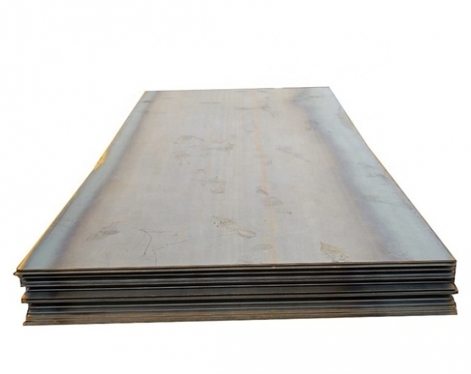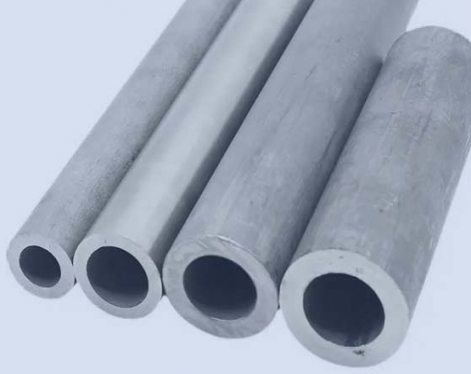Environmental Control: Creating a Dry Protective Barrier
1. Temperature and humidity management
The storage environment of carbon steel plates must be kept dry and ventilated, which is the key to preventing them from rusting and deteriorating. Strictly controlling the relative humidity below 60% can effectively slow down the rate of oxidation and corrosion. At the same time, drastic temperature changes should be avoided as much as possible, because sudden changes in temperature will cause the carbon steel plate to expand and contract, which may damage the surface structure and increase the risk of rust.
2. Isolation of hazardous substances
It is strictly forbidden to store carbon steel plates together with corrosive chemicals such as acids and alkalis. Even a small amount of volatilization of acid and alkali substances may react chemically with the carbon steel plates and cause serious corrosion. At the same time, keep carbon steel plates away from fire sources, because high temperature will not only change its physical properties, but may also cause fire. In addition, high salt environments are also highly corrosive to carbon steel plates. To prevent the carbon steel plate from directly contacting the ground moisture, a moisture-proof layer such as wood or plastic sheeting can be laid on the ground, and the carbon steel plate can be raised by more than 10cm.

Surface protection: forming a double anti-rust layer
1. Cleaning pretreatment
Regular cleaning of carbon steel plates is essential. Use a neutral detergent and a soft cleaning cloth to gently wipe the surface to easily remove dust and oil stains. If there is no neutral detergent, you can also use compressed air to blow away the surface dust. For areas with more oil, you can use a special oil cleaner to treat them. It should be noted that after cleaning, make sure the carbon steel plate is completely dry, as residual moisture will accelerate rusting. The carbon steel plate can be placed in a ventilated place to dry naturally, or it can be wiped dry with a clean dry cloth to eliminate the hidden dangers caused by residual moisture.
2. Anti-rust coating treatment
Anti-rust coating treatment can effectively protect carbon steel plates and prevent them from rusting. For carbon steel plates that are stored for a short period of time, apply a thin layer of oil after cleaning and drying. Motor oil and anti-rust oil are good choices. If you plan to store it for a long time, more effective anti-rust treatment is required. Spraying anti-rust paint is a common method. Carbon steel plates can also be galvanized or chrome-plated to cover a layer of zinc or chromium on the surface, which significantly improves corrosion resistance and allows carbon steel plates to remain in good condition during long-term storage.
Standardized stacking: avoid physical damage
1. Classify and stack
When stacking carbon steel plates, they must be strictly classified according to thickness and specifications. If carbon steel plates of different thicknesses and specifications are mixed, it will not only be inconvenient to use, but it will also easily cause collision damage during transportation. Shelves or pallets can be used to support carbon steel plates and keep them at a certain distance from the ground, which can not only prevent moisture but also facilitate the operation of forklifts and other handling equipment.
2. Clear labeling
Each pile of carbon steel plates must be clearly labeled with key information such as material, specifications, and storage date. Material information can help staff quickly determine the applicable scenarios of the board and avoid using the wrong material; specification marking makes it easy to accurately find the required board during the retri process; The warehousing date is very important for the implementation of the first-in, first-out principle, which helps to ensure the reasonable turnover of inventory materials and prevent quality problems caused by long-term backlogs.
Regular maintenance: stop loss in time
1. Visual inspection
Performing a visual inspection of carbon steel plates once a week is an important step in identifying potential problems in a timely manner. Carefully check the surface for rust spots, even the smallest ones, and pay attention to any discoloration. For welds and edges, which are easily overlooked but prone to problems, it is important to check
2. Sealing test
For carbon steel plates for special purposes, such as those used in the manufacture of pressure vessels, regular leak tightness testing is essential. Generally speaking, water pressure or air pressure testing methods can be used. It can avoid serious accidents caused by sealing problems and ensure production safety and the safety of personnel and property.
Read more: What is the Difference between Carbon Steel Plates and Steel Plates?
1. Temperature and humidity management
The storage environment of carbon steel plates must be kept dry and ventilated, which is the key to preventing them from rusting and deteriorating. Strictly controlling the relative humidity below 60% can effectively slow down the rate of oxidation and corrosion. At the same time, drastic temperature changes should be avoided as much as possible, because sudden changes in temperature will cause the carbon steel plate to expand and contract, which may damage the surface structure and increase the risk of rust.
2. Isolation of hazardous substances
It is strictly forbidden to store carbon steel plates together with corrosive chemicals such as acids and alkalis. Even a small amount of volatilization of acid and alkali substances may react chemically with the carbon steel plates and cause serious corrosion. At the same time, keep carbon steel plates away from fire sources, because high temperature will not only change its physical properties, but may also cause fire. In addition, high salt environments are also highly corrosive to carbon steel plates. To prevent the carbon steel plate from directly contacting the ground moisture, a moisture-proof layer such as wood or plastic sheeting can be laid on the ground, and the carbon steel plate can be raised by more than 10cm.

Surface protection: forming a double anti-rust layer
1. Cleaning pretreatment
Regular cleaning of carbon steel plates is essential. Use a neutral detergent and a soft cleaning cloth to gently wipe the surface to easily remove dust and oil stains. If there is no neutral detergent, you can also use compressed air to blow away the surface dust. For areas with more oil, you can use a special oil cleaner to treat them. It should be noted that after cleaning, make sure the carbon steel plate is completely dry, as residual moisture will accelerate rusting. The carbon steel plate can be placed in a ventilated place to dry naturally, or it can be wiped dry with a clean dry cloth to eliminate the hidden dangers caused by residual moisture.
2. Anti-rust coating treatment
Anti-rust coating treatment can effectively protect carbon steel plates and prevent them from rusting. For carbon steel plates that are stored for a short period of time, apply a thin layer of oil after cleaning and drying. Motor oil and anti-rust oil are good choices. If you plan to store it for a long time, more effective anti-rust treatment is required. Spraying anti-rust paint is a common method. Carbon steel plates can also be galvanized or chrome-plated to cover a layer of zinc or chromium on the surface, which significantly improves corrosion resistance and allows carbon steel plates to remain in good condition during long-term storage.
Standardized stacking: avoid physical damage
1. Classify and stack
When stacking carbon steel plates, they must be strictly classified according to thickness and specifications. If carbon steel plates of different thicknesses and specifications are mixed, it will not only be inconvenient to use, but it will also easily cause collision damage during transportation. Shelves or pallets can be used to support carbon steel plates and keep them at a certain distance from the ground, which can not only prevent moisture but also facilitate the operation of forklifts and other handling equipment.
2. Clear labeling
Each pile of carbon steel plates must be clearly labeled with key information such as material, specifications, and storage date. Material information can help staff quickly determine the applicable scenarios of the board and avoid using the wrong material; specification marking makes it easy to accurately find the required board during the retri process; The warehousing date is very important for the implementation of the first-in, first-out principle, which helps to ensure the reasonable turnover of inventory materials and prevent quality problems caused by long-term backlogs.
Regular maintenance: stop loss in time
1. Visual inspection
Performing a visual inspection of carbon steel plates once a week is an important step in identifying potential problems in a timely manner. Carefully check the surface for rust spots, even the smallest ones, and pay attention to any discoloration. For welds and edges, which are easily overlooked but prone to problems, it is important to check
2. Sealing test
For carbon steel plates for special purposes, such as those used in the manufacture of pressure vessels, regular leak tightness testing is essential. Generally speaking, water pressure or air pressure testing methods can be used. It can avoid serious accidents caused by sealing problems and ensure production safety and the safety of personnel and property.
Read more: What is the Difference between Carbon Steel Plates and Steel Plates?









